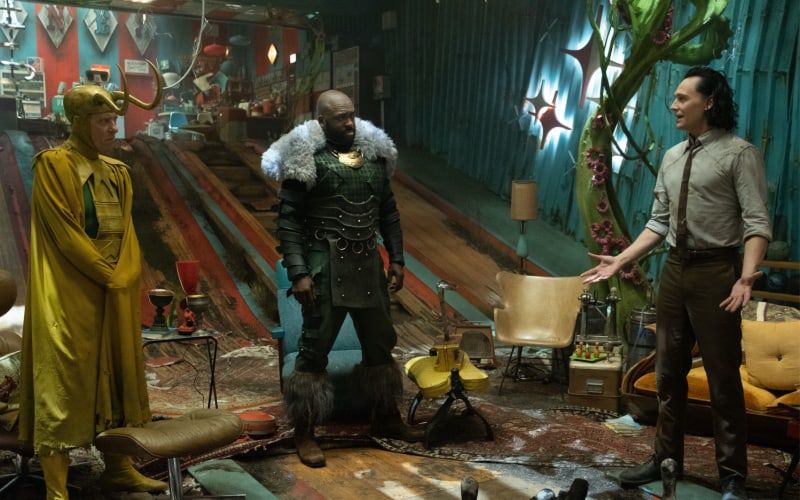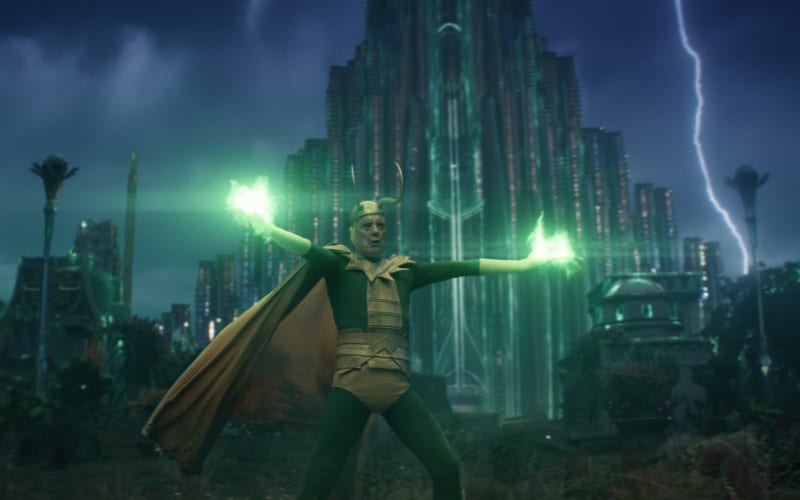Welcome to World Builders, our ongoing series of conversations with the most productive and thoughtful behind-the-scenes craftspeople. In this entry, we chat with costume designer Christine Wada and production designer Kasra Farhani about the humiliating fashion and design built into Loki.
The God of Mischief might miss his fine ass-gardian leather, but we sure don’t. Mere minutes into the Marvel Cinematic Universe series Loki, the wannabe despot has his robes vaporized from his person and replaced with the TVA uniform: a white, buttoned-up shirt choked at the neck with a thin brown tie and encased with an even blander dust-colored jacket. It’s prim, but not proper.
Tom Hiddleston initially wears the costume like shackles, but as Loki progresses, his character sheds the parts that don’t work for him. By Episode 5, he stands in those TVA duds as tall as he ever did. Thanks to a gift from his child variant, he makes his own addition, fabricating a scabbard to carry the lovely dagger on his back.
Loki is at a point of no return. Hunkered within the Void located at the end of time, he is surrounded by dark mirrors of himself. Richard E. Grant represents the Classic Loki ripped from the cover of The Avengers #1. Jack Veal is his youthful doppelganger, who sneers and swaggers as the only Loki to eradicate their brother.
And, there’s the alligator, and the President, and the Loki with forks for horns. They’re all rather embarrassing, really.
The Loki Costume Design
Costume designer Christine Wada wished to mortify Loki through bureaucratic dress. She delighted in removing the grandeur and strapping Hiddleston into the dullest drab she could concoct. And while there was devilish bliss found in such decisions, those choices were all made to serve the narrative.
“It’s a pretty obvious story decision for us to take the armor away,” says Wada. “Loki had to go on an inward journey, stripped from his armor. We started him at a point of humiliation that he could build from. We tried many different illustrations, wanting to pare it back. [The audeince] sees how you can put Loki in a middle-management uniform, but he will make it Loki pretty fast.”
Inspiration from The Big Lebowski
That inability to escape Loki fed production designer Kasra Farahani‘s creativity as well. Every nook and cranny on the set is stuffed with character. Loki’s many personalities, manifested by the seemingly endless variants that inhabit the Void, drown the frame. Farahani wants Hiddleston’s Loki to feel assaulted by the others. Loki should want to hide, but there is nowhere to duck and cover, and there is no hiding from yourself.
“It helps us to create a more fully realized environment,” says Farahani. “It’s got to feel complete and specific and tactile. That environment is packed with tons of beautiful things that our set decorator, Claudia [Bonfe], brought in. There are some really fun easter eggs. There’s the Polybius machine that our creative producer, Kevin [Wright], suggested, and there was probably a small part of me that wanted to pay homage to the bowling alley from The Big Lebowski.”
The Loki Set Design
Episode 5’s Loki den was a critical construction. Our Loki is dropped in its center and forced to absorb everything he is, was, or could be. It was not written as a room worthy of Lebowski homage, but Farahani made it so, and once he did, all the other decorations rapidly swarmed inside.

“That set was one where we had a lot of latitudes,” Farahani continues. “In the script, it just described it as a temple. Not a lot of description there, so we were able to propose this whacked-out thing. I thought it would be cool to have a cheeky mid-century bowling alley. To have it look like you took a bowling alley and broke it over your knee a couple of times. It’s so fractured that when you enter it, the lane lines are running down this vector, directing the eye to this throne. And I thought it would be funny to have these Lokis raid out a mall Santa from some deleted reality.”
Costuming the Loki Variants
Wada saw the Lokis as dumpster divers. Whatever trash the TVA dropped on their heads would go into their outfits. Lokis make the world theirs, not the other way around.
“I went through history,” says Wada. “And into the world and tried to pluck — as if you just took a quick screen-grab of a time and a place or an event. How would a Loki assemble from that moment? The Prisoner Loki has a weapon made from one of the last Faberge eggs. I tried to find a few things in history that have disappeared and that a Loki might’ve found, or maybe they stole! They look like they took what they were given and fashioned it into Loki gear, like bicycle handlebars into horns. Whatever they have, they will always make it a Loki costume at the end of the day.”
The Classic Loki Costume
And while Tom Hiddleston’s Loki looks for any shadow to slink his TVA-draped self inside, Richard Grant’s Loki screams dominance to the younglings scuttling about his feet. He wears his tights with confidence and belief, a station that took some tinkering to locate.
“At the first fitting,” Wada says of the Classic Loki costume, “I think Richard was really disappointed that he didn’t get to have a muscle suit. But little does he know that he has so much muscle as an actor that you would never want to give him a muscle suit. And then that cape he has became his muscle suit.”

Capturing Classic Loki’s comic book aesthetic was incredibly tricky. Wada and her artists went through numerous drafts before they landed on the final look. They knew Classic Loki had to appear vintage and not overly rendered into the expected and heavily textured Marvel movie attire. Ultimately, however, Grant sold the piece.
“It’s how the person moves in it,” Wada says. “Their comfortability. But also, I will say that the aging process on [the costume] was really the biggest deal. Just trying to figure out how we could make it feel old like he’d lived in that world forever, but not making him look totally sad because you didn’t want it to feel like he was sad and pathetic.”
Diverging from the Comic Books
For longtime comic book fans, Grant’s Loki, in that costume, is a miraculous image that we worry is a mirage. Why can’t all Marvel’s movie characters look as if they stepped off the pages? Farahani warns us away from such thinking. His job is not to replicate what’s already available. Those comics are on the shelf. They’re in your collection already. Those stories don’t need realization.
“The source material is the starting point,” says Farahani. “That’s where all this stuff begins. You see what’s there, and you pay homage to it. But the goal for the creative people working on these things, and for the audience that enjoys watching them, is to expand the MCU. It’s to make the world bigger, to have more, to see more, and to comment on it and to explore. The easter eggs are a good way of bridging these two things. You build a new environment, and then you acknowledge the history through these easter eggs. The Thanos-copter, the Polybius machine, they add more narrative depth for the audience to probe.”
The Marvel comics are merely another multiverse branch. The Lokis found there bare resemblance to the Lokis found on Disney+, but they’re not the same. They’re family, sure. Some would get along with each other, but most would not. And if Tom Hiddleston’s Episode 5 Loki slipped into the pages decked out in his TVA wardrobe, he’d immediately turn about and walk away.
Right now, he needs some alone time to figure things out. He’s had enough of himself. And he doesn’t care what those other Lokis might think of his shirt and tie.
Loki is now streaming on Disney+.

0 comments:
Post a Comment